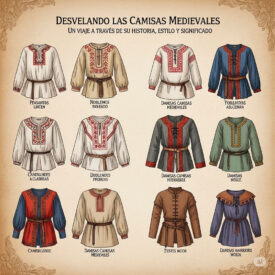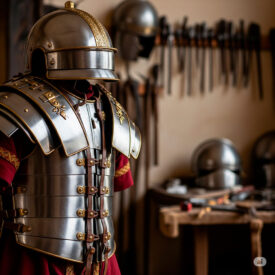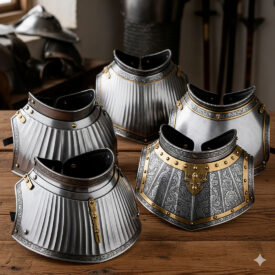What protected the legionary when the metal armor struck the body? Imagine the arena of a Roman camp, the creak of leather and the jingle of the plates: between the metal and the skin existed a silent and vital garment: the Roman Subarmalis, designed to turn the brutality of combat into bearable resistance for the warrior.
In this article, you will discover why the subarmalis was more than just simple padding: how it cushioned impacts, distributed the weight of the lorica segmentata, adjusted to the body, and evolved with Rome’s tactical needs. We will also explore materials, variants, historical context, and its specific adaptation to the lorica segmentata.
From origin to adaptation with the Lorica Segmentata
25 BC: Documented appearance of early padded and leather versions; 1st century AD: transformation and adaptation for use under the lorica segmentata; subsequent centuries: diffusion and variations in the Empire and Byzantium as a protective and status garment.

Primary function under the Lorica Segmentata
The Roman Subarmalis acted as a second skin between the body and the cuirass. It not only cushioned direct impacts but also protected against chafing and bruises that the rigid armor did not absorb.
Under the lorica segmentata, its tasks became specific: distributing the weight of the plates, preventing the plates from digging in or chafing the skin, and keeping the armor stable during marches and the clash of formations.

Cushioning and weight distribution
The lorica segmentata, due to its segmented and rigid design, exerted pressure points on the shoulders and sides. The subarmalis mitigated these points with layers of leather or padded fabric, often with padding on the shoulder pads to prevent straps and plates from scratching the flesh.
Complementary protection where armor does not reach
Some versions included leather lambrequins or pterygas over the hips and armpits, covering areas that the lorica segmentata left exposed. This offered protection against cuts and reduced exposure in close-quarters combat.
Materials, construction and adjustment
The subarmalis was mainly made of treated leather and padded fabrics (linen, wool). Leathers of 2-3 mm were common to withstand wear, while the internal padding absorbed the energy of blows.
The adjustment was made using laces and front closures that allowed the garment to be tightened to the torso. This fastening prevented the movement of the armor and improved the ergonomics of the soldier in formation and during the run.
Variants and rank badges
From simple sleeveless vests to ornate versions for officers, the subarmalis varied in thickness and ornamentation. Double lambrequins and embroidery indicated status; at high levels they could be used as a decorative civilian garment.
| Aspect | Function | Typical Material | Notes |
|---|---|---|---|
| Cushioning | Absorb impacts | Padded fabrics (linen/wool) | Reduces contusions from blunt blows |
| Weight distribution | Avoid pressure points | Treated leather | Pads on shoulder pads and sides |
| Additional protection | Cover exposed areas | Leather with lambrequins | Protects hips and upper thighs |
- Practical summary
-
- Function: Cushion, protect and stabilize the armor.
- Material: Leather and textile padding.
- Adjustment: Laces and front closures.
Tactics and use in formation
In the legion, discipline turned individual protection into a collective advantage. The subarmalis allowed the legionary to endure long marches with less fatigue and to hold the battle line without minor wounds or chafing compromising operational capacity.
When the lorica segmentata limited the use of belts to distribute weight, soldiers resorted to internal solutions: layers of leather under shoulder pads, subarmalis adjustments, and complementary elements that redistributed the load to the shoulders and torso.
Historical evolution
Starting from Greek garments, the subarmalis became a characteristic element of Roman equipment. With the popularization of the lorica segmentata, it was adapted to fit with the plates and straps, and over time it took on variants that responded to both functionality and social symbolism.
Comparison: Subarmalis under Lorica Hamata vs Lorica Segmentata
 The lorica hamata (chainmail) offered more continuous coverage; therefore, the subarmalis for hamata prioritized padding. With the lorica segmentata, the garment was oriented to mitigate rigid points and protect areas exposed by the plates.
The lorica hamata (chainmail) offered more continuous coverage; therefore, the subarmalis for hamata prioritized padding. With the lorica segmentata, the garment was oriented to mitigate rigid points and protect areas exposed by the plates.
Clearing up unknowns about the Roman Subarmalis
How did the Roman Subarmalis differ from other pieces of armor?
The Roman Subarmalis differed from other pieces of armor because it was a padded or treated leather garment placed under the main armor (such as the lorica hamata or segmentata) to provide additional protection by cushioning impacts and preventing the armor from directly damaging the soldier’s body. In addition, it had an adjustable design with laces or closures to remain firm during combat and provided durability and comfort, something that other armors did not offer at the same level in their cushioning and close-fitting function. In summary, it fulfilled the function of a protective layer between the body and the metal armor, something unique compared to external or rigid armor pieces.
What specific materials were used to manufacture the Roman Subarmalis?
The Roman Subarmalis was mainly manufactured with treated leather (vegetable-tanned leather) and padded fabrics. The leather usually had an approximate thickness of 2-3 mm to offer durability and resistance, while the padded fabrics provided cushioning against impacts. This garment was used under armor to protect and cushion blows during combat. Some subarmalis were completely made of leather, others could have padded textile structures for greater comfort and protection.
In what specific situations was the Roman Subarmalis most effective?
The Roman Subarmalis was especially effective in situations of intense, close-quarters combat where soldiers faced multiple types of threats.
Contexts of maximum effectiveness
In direct combat with impact weapons
The Subarmalis proved particularly valuable when legionaries faced sword blows and blunt weapons. Its padded design, frequently made with multiple layers of linen, wool, and reinforced with leather, effectively cushioned the impact of these attacks, reducing the risk of severe contusions and fractures.
Under heavy chainmail armor
The garment demonstrated its maximum utility when strategically placed under the lorica hamata (chainmail) or the lorica segmentata. In these situations, it not only provided additional protection against blows but also protected the combatant from the damaging effects of his own armor, preventing metal chafing against the skin and preventing wear and tear on underwear.
In coordinated formations
Considering that Roman tactics were based on discipline, formation, and coordinated action, the Subarmalis allowed legionaries to resist longer in combat effectively. This increased durability and resistance amplified the tactical possibilities of Roman commanders, allowing complex maneuvers without soldiers suffering rapidly incapacitating injuries.
In summary, the Subarmalis was most effective precisely in the scenarios for which it was designed: under heavy metal armor, during prolonged hand-to-hand engagements, where impact absorption and full torso protection were decisive for the Roman soldier’s survival.
What historical evolutions did the Roman Subarmalis undergo throughout the Roman Empire?
The Roman Subarmalis underwent significant changes throughout the Roman Empire, adapting to new forms of armor and combat needs.
Origin and first versions
 The design of the Subarmalis was inspired by more primitive versions used by Greek peoples. The Romans made adjustments that optimized its functionality and comfort, making it an essential element of the Roman military arsenal.
The design of the Subarmalis was inspired by more primitive versions used by Greek peoples. The Romans made adjustments that optimized its functionality and comfort, making it an essential element of the Roman military arsenal.
Formal appearance and initial features
The Subarmalis appeared around 25 BC. In its early versions, it was a padded garment that Roman legionaries wore over the tunic to protect themselves from the chafing of the armor. It was generally made of treated leather or padded fabrics, crafted with multiple layers of linen or wool, often reinforced with leather or even metal plates integrated into the shoulders and torso. It had laces or closures that allowed a snug fit to the body, ensuring that the garment would not move during combat.
Adaptation to the lorica segmentata
A fundamental transformation occurred during the 1st century AD with the widespread adoption of the lorica segmentata. The use of the subarmalis transformed to adapt to the new cuirass, modifying its design to be compatible with this type of segmented armor. This evolution responded to the need to maintain protective functionality under armor with structural characteristics different from the lorica hamata (chainmail).
Transversal function in military history
Throughout its evolution, the Subarmalis maintained its fundamental purpose: to cushion the impact of enemy weapons in hand-to-hand combat and to protect the soldier’s torso, reducing the risk of serious injuries. Its utility paved the way for the evolution of military clothing and laid the foundations for future innovations in personal protection.
How did the Roman Subarmalis adjust to the soldier’s body?
The Roman Subarmalis was adjusted to the soldier’s body with laces or side closures, which allowed it to be tightly fastened and the fit personalized for greater comfort and effectiveness in combat.
VIEW ROMAN SUBARMALIS | VIEW LORICA HAMATA AND LORICA SEGMENTATA
The subarmalis demonstrates how an apparently modest garment made the difference between collapse and cohesion on the battlefield. Its practical design and its adaptation to the lorica segmentata show the combination of technical ingenuity and Roman military experience. Think of it as the invisible key that turned the hardness of metal into mobility and resistance for the legionary.








